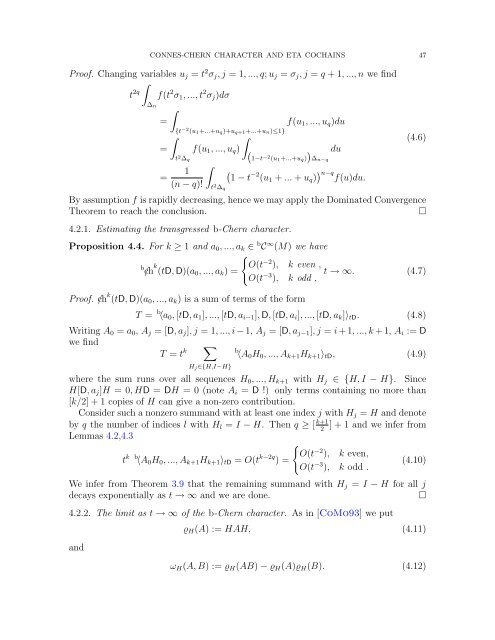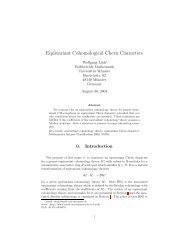Connes-Chern Character for Manifolds with Boundary and ETA ...
Connes-Chern Character for Manifolds with Boundary and ETA ...
Connes-Chern Character for Manifolds with Boundary and ETA ...
Create successful ePaper yourself
Turn your PDF publications into a flip-book with our unique Google optimized e-Paper software.
CONNES-CHERN CHARACTER AND <strong>ETA</strong> COCHAINS 47<br />
Proof. Changing variables u j = t 2 σ j , j = 1, ..., q; u j = σ j , j = q + 1, ..., n we find<br />
t<br />
∫∆ 2q f(t 2 σ 1 , ..., t 2 σ j )dσ<br />
n<br />
∫<br />
=<br />
{t −2 (u 1 +...+u q)+u q+1 +...+u n)≤1}<br />
f(u 1 , ..., u q )du<br />
∫<br />
∫<br />
(4.6)<br />
= f(u 1 , ..., u q ) (<br />
du<br />
t 2 ∆ q 1−t −2 (u 1 +...+u q)<br />
)∆ n−q<br />
∫<br />
1 (<br />
=<br />
1 − t −2 (u 1 + ... + u q ) ) n−q<br />
f(u)du.<br />
(n − q)! t 2 ∆ q<br />
By assumption f is rapidly decreasing, hence we may apply the Dominated Convergence<br />
Theorem to reach the conclusion.<br />
□<br />
4.2.1. Estimating the transgressed b-<strong>Chern</strong> character.<br />
Proposition 4.4. For k ≥ 1 <strong>and</strong> a 0 , ..., a k ∈ b C ∞ (M) we have<br />
{<br />
b /ch k O(t −2 ), k even ,<br />
(tD, D)(a 0 , ..., a k ) =<br />
t → ∞. (4.7)<br />
O(t −3 ), k odd ,<br />
Proof. /ch k (tD, D)(a 0 , ..., a k ) is a sum of terms of the <strong>for</strong>m<br />
T = b 〈a 0 , [tD, a 1 ], ..., [tD, a i−1 ], D, [tD, a i ], ..., [tD, a k ]〉 tD . (4.8)<br />
Writing A 0 = a 0 , A j = [D, a j ], j = 1, ..., i − 1, A j = [D, a j−1 ], j = i + 1, ..., k + 1, A i := D<br />
we find<br />
∑<br />
T = t k<br />
b 〈A 0 H 0 , ..., A k+1 H k+1 〉 tD , (4.9)<br />
H j ∈{H,I−H}<br />
where the sum runs over all sequences H 0 , ..., H k+1 <strong>with</strong> H j ∈ {H, I − H}. Since<br />
H[D, a j ]H = 0, HD = DH = 0 (note A i = D !) only terms containing no more than<br />
[k/2] + 1 copies of H can give a non-zero contribution.<br />
Consider such a nonzero summ<strong>and</strong> <strong>with</strong> at least one index j <strong>with</strong> H j = H <strong>and</strong> denote<br />
by q the number of indices l <strong>with</strong> H l = I − H. Then q ≥ [ k+1 ] + 1 <strong>and</strong> we infer from<br />
2<br />
Lemmas 4.2,4.3<br />
{<br />
t k b 〈A 0 H 0 , ..., A k+1 H k+1 〉 tD = O(t k−2q O(t −2 ), k even,<br />
) =<br />
(4.10)<br />
O(t −3 ), k odd .<br />
We infer from Theorem 3.9 that the remaining summ<strong>and</strong> <strong>with</strong> H j = I − H <strong>for</strong> all j<br />
decays exponentially as t → ∞ <strong>and</strong> we are done.<br />
□<br />
4.2.2. The limit as t → ∞ of the b-<strong>Chern</strong> character. As in [CoMo93] we put<br />
<strong>and</strong><br />
ϱ H (A) := HAH, (4.11)<br />
ω H (A, B) := ϱ H (AB) − ϱ H (A)ϱ H (B). (4.12)

















